Evolution Characteristics of Suction-Side-Perpendicular Cavitating Vortex in Axial Flow Pump under Low Flow Condition
Abstract
:1. Introduction
2. Test Model Device and Numerical Simulation Method
2.1. Model Test
2.1.1. Experimental Equipment and Instruments
2.1.2. Uncertainty Analysis of Efficiency Test
- Uncertainty analysis of the test bench system
- 2.
- Random uncertainty of efficiency test
- 3.
- Total uncertainty of efficiency test
2.2. Numerical Simulation
2.2.1. Grid Generation
2.2.2. Governing Equation
2.2.3. Boundary Conditions
2.2.4. Grid-Independent Verification
2.2.5. Comparison between Numerical Simulation and Experiment
3. Results and Analysis
3.1. Cavitation Analysis
3.1.1. Cavitation Morphology Evolution Law
3.1.2. The Change of Turbulent Kinetic Energy and Eddy Viscosity of Cavitation Shedding
3.2. Suction-Side-Perpendicular Cavitating Vortex
3.2.1. Identification of Vortices
3.2.2. SSPCV Velocity Gradient
3.2.3. SSPCV Vortex Kinetic Energy
3.3. Vorticity Analysis in Impeller of Axial Flow Pump
3.4. Method Comparison
4. Conclusions
Author Contributions
Funding
Institutional Review Board Statement
Informed Consent Statement
Data Availability Statement
Conflicts of Interest
Nomenclature
| Symbol | Description |
| Qd | The design flow |
| The system uncertainty of efficiency test | |
| The system uncertainty of flow measurement | |
| The system uncertainty of torque measurement | |
| Standard deviation of average efficiency value | |
| Correction coefficient | |
| , | Empirical constants of |
| Turbulent kinetic energy | |
| Mixed functions | |
| β*, β, α, α1, αk, σω, σω2 | Empirical coefficients of turbulence model |
| Turbulence viscosity | |
| Mass transfer source terms connected to the growth of the vapor bubbles | |
| Vapor volume fraction | |
| Vapor density | |
| Mixed density | |
| Inlet pressure | |
| R | Value of liutex method |
| , | The velocity gradient in the x, y direction |
| Angular velocity | |
| Relative vorticity | |
| Turbulence viscosity | |
| Random uncertainty of efficiency test | |
| Total uncertainty of efficiency test | |
| The systematic uncertainty of static head measurement | |
| EN | The system uncertainty of speed measurement |
| Correction function considering the influence of rotation and curvature | |
| Rotation correction factor | |
| E | The kinetic energy of the vortex |
| The invariant of strain rate | |
| Turbulence frequency | |
| , | The functions of rotation speed of the system |
| Dynamic viscosity | |
| Mass transfer source terms connected to the collapse of the vapor bubbles | |
| Saturation vapor pressure | |
| Liquid density | |
| σ | Cavitation number |
| The speed at the rim | |
| The velocity gradient | |
| u, v, w | The component of the absolute velocity in the x, y, z direction |
| Relative velocity | |
| Kinematic viscosity |
References
- Higashi, S.; Yoshida, Y.; Tsujimoto, Y. Tip leakage vortex cavitation from the tip clearance of a single hydrofoil. JSME Int. J. Ser. B-Fluids Therm. Eng. 2002, 45, 662–671. [Google Scholar] [CrossRef] [Green Version]
- Coutier-Delgosha, O.; Stutz, B.; Vabre, A.; Legoupil, S. Analysis of cavitating flow structure by experimental and numerical investigations. J. Fluid Mech. 2007, 578, 171–222. [Google Scholar] [CrossRef] [Green Version]
- Huang, B.; Young, Y.L.; Wang, G.; Shyy, W. Combined Experimental and Computational Investigation of Unsteady Structure of Sheet/Cloud Cavitation. J. Fluids Eng. Trans. ASME 2013, 135, 071301. [Google Scholar] [CrossRef]
- Leroux, J.B.; Astolfi, J.A.; Billard, J.Y. An experimental study of unsteady partial cavitation. J. Fluids Eng. Trans. ASME 2004, 126, 94–101. [Google Scholar] [CrossRef]
- Kadivar, E.; Timoshevskiy, M.V.; Pervunin, K.S.; el Moctar, O. Cavitation control using Cylindrical Cavitating-bubble Generators (CCGs): Experiments on a benchmark CAV2003 hydrofoil. Int. J. Multiph. Flow 2020, 125, 103186. [Google Scholar] [CrossRef]
- Mejri, I.; Bakir, F.; Rey, R.; Belamri, T. Comparison of computational results obtained from a homogeneous cavitation model with experimental investigations of three inducers. J. Fluids Eng. Trans. ASME 2006, 128, 1308–1323. [Google Scholar] [CrossRef]
- Lee, K.-H.; Yoo, J.-H.; Kang, S.-H. Experiments on cavitation instability of a two-bladed turbopump inducer. J. Mech. Sci. Technol. 2009, 23, 2350–2356. [Google Scholar] [CrossRef]
- Choi, Y.-D.; Kurokawa, J.; Imamura, H. Suppression of cavitation in inducers by J-Grooves. J. Fluids Eng. Trans. ASME 2007, 129, 15–22. [Google Scholar] [CrossRef]
- Bensow, R.E.; Bark, G. Implicit LES Predictions of the Cavitating Flow on a Propeller. J. Fluids Eng. Trans. ASME 2010, 132, 041302. [Google Scholar] [CrossRef]
- Peters, A.; Lantermann, U.; el Moctar, O. Numerical prediction of cavitation erosion on a ship propeller in model- and full-scale. Wear 2018, 408, 1–12. [Google Scholar] [CrossRef]
- Kumar, P.; Saini, R.P. Study of cavitation in hydro turbines-A review. Renew. Sustain. Energy Rev. 2010, 14, 374–383. [Google Scholar] [CrossRef]
- Liu, Y.; Tan, L. Tip clearance on pressure fluctuation intensity and vortex characteristic of a mixed flow pump as turbine at pump mode. Renew. Energy 2018, 129, 606–615. [Google Scholar] [CrossRef]
- Huang, R.; Ji, B.; Luo, X.; Zhai, Z.; Zhou, J. Numerical investigation of cavitation-vortex interaction in a mixed-flow waterjet pump. J. Mech. Sci. Technol. 2015, 29, 3707–3716. [Google Scholar] [CrossRef]
- Guo, Q.; Huang, X.; Qiu, B. Numerical investigation of the blade tip leakage vortex cavitation in a waterjet pump. Ocean Eng. 2019, 187, 106170. [Google Scholar] [CrossRef]
- Zhang, D.; Shi, W.; van Esch, B.P.M.; Shi, L.; Dubuisson, M. Numerical and experimental investigation of tip leakage vortex trajectory and dynamics in an axial flow pump. Comput. Fluids 2015, 112, 61–71. [Google Scholar] [CrossRef]
- Shi, L.; Zhang, D.; Jin, Y.; Shi, W.; van Esch, B.P.M. A study on tip leakage vortex dynamics and cavitation in axial-flow pump. Fluid Dyn. Res. 2017, 49, 035504. [Google Scholar] [CrossRef]
- Zhang, D.; Shi, W.; Pan, D.; Dubuisson, M. Numerical and Experimental Investigation of Tip Leakage Vortex Cavitation Patterns and Mechanisms in an Axial Flow Pump. J. Fluids Eng. Trans. ASME 2015, 137, 121103. [Google Scholar] [CrossRef]
- Shen, X.; Zhang, D.; Xu, B.; Jin, Y.; Shi, W.; van Esch, B.P.M. Experimental Investigation of the Transient Patterns and Pressure Evolution of Tip Leakage Vortex and Induced-Vortices Cavitation in an Axial Flow Pump. J. Fluids Eng. Trans. ASME 2020, 142, 101206. [Google Scholar] [CrossRef]
- Zhang, D.; Shi, L.; Shi, W.; Zhao, R.; Wang, H.; van Esch, B.P.M. Numerical analysis of unsteady tip leakage vortex cavitation cloud and unstable suction-side-perpendicular cavitating vortices in an axial flow pump. Int. J. Multiph. Flow 2015, 77, 244–259. [Google Scholar] [CrossRef]
- Liu, C.; Gao, Y.S.; Dong, X.R.; Wang, Y.Q.; Liu, J.M.; Zhang, Y.N.; Cai, X.S.; Gui, N. Third generation of vortex identification methods: Omega and Liutex/Rortex based systems. J. Hydrodyn. 2019, 31, 205–223. [Google Scholar] [CrossRef]
- Wang, Y.-Q.; Gao, Y.-S.; Liu, J.-M.; Liu, C. Explicit formula for the Liutex vector and physical meaning of vorticity based on the Liutex-Shear decomposition. J. Hydrodyn. 2019, 31, 464–474. [Google Scholar] [CrossRef]
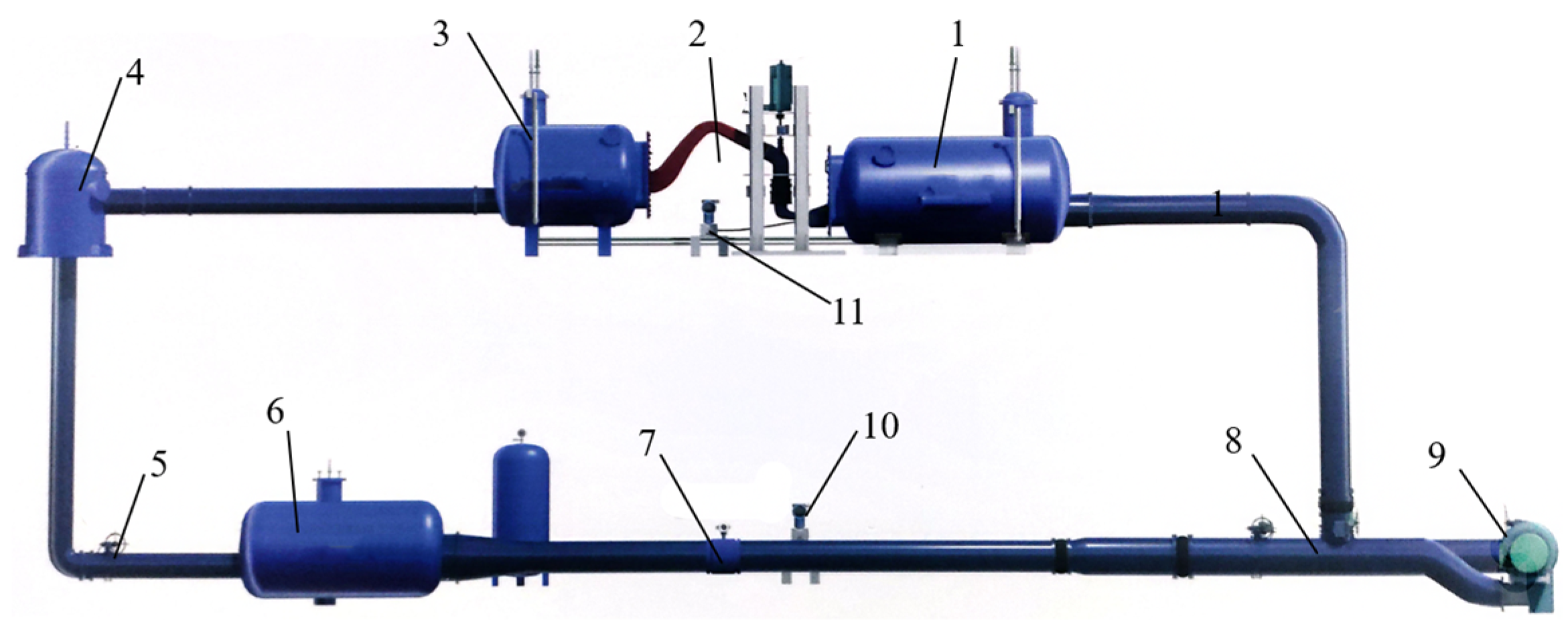

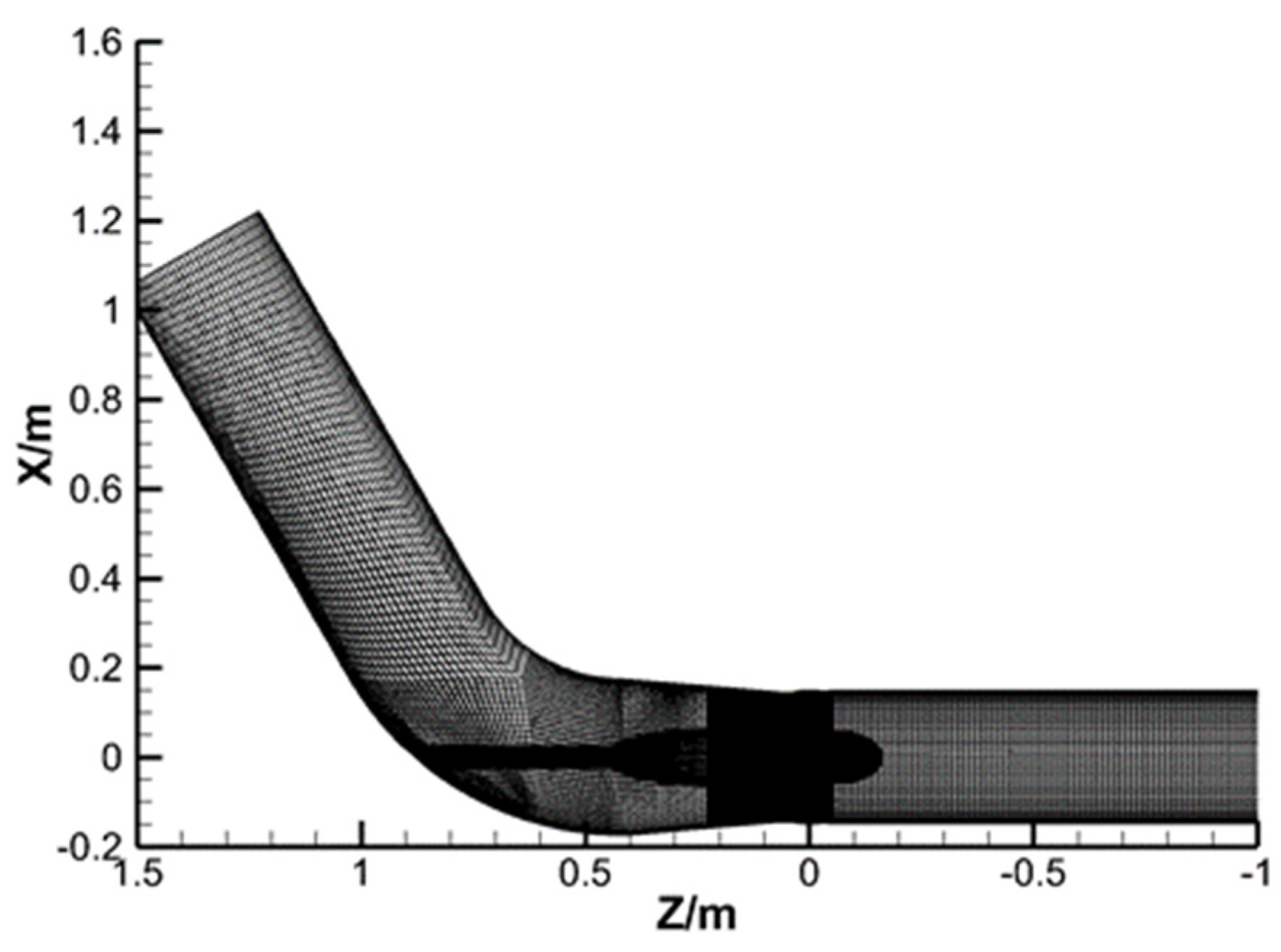


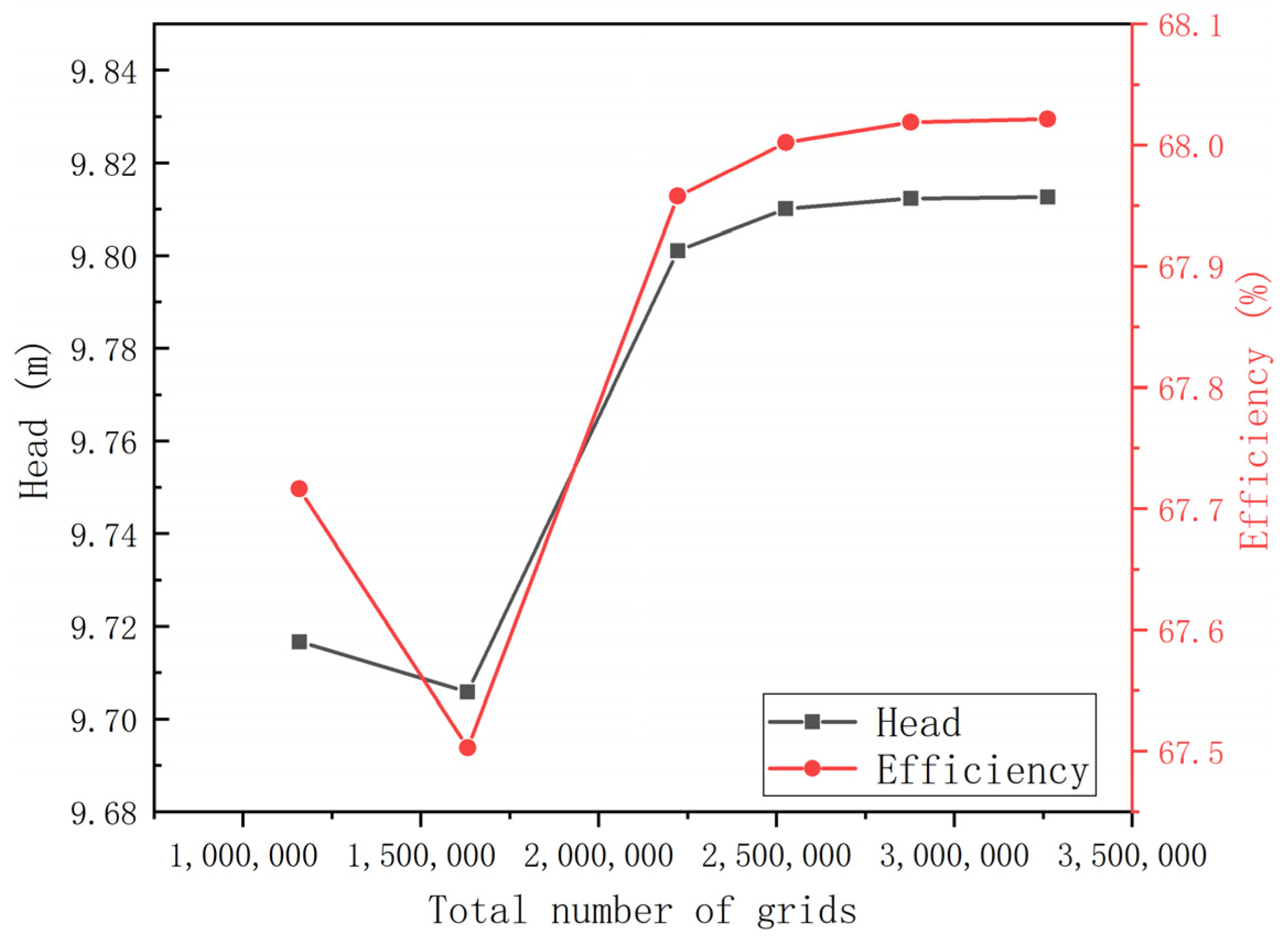
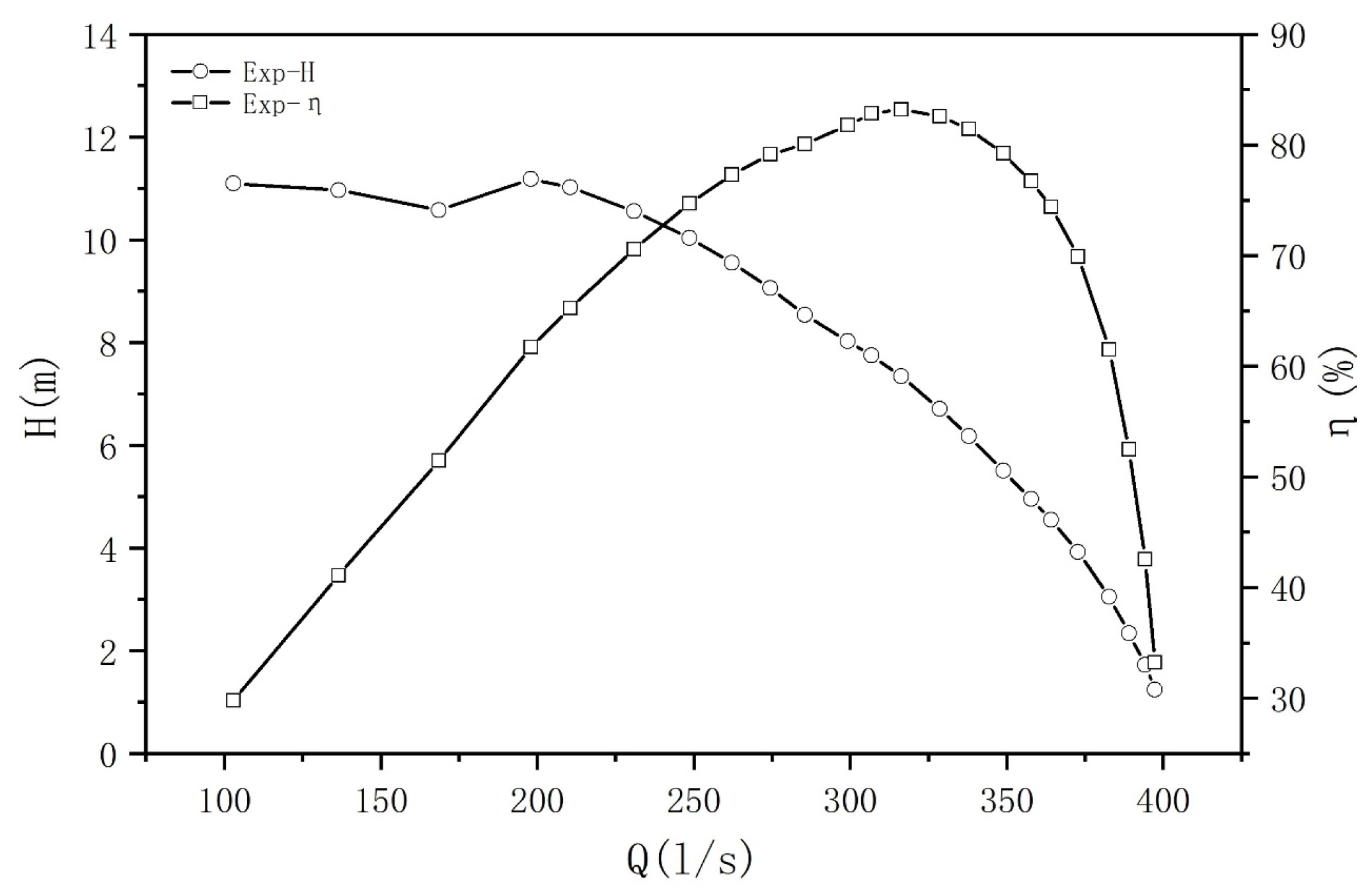
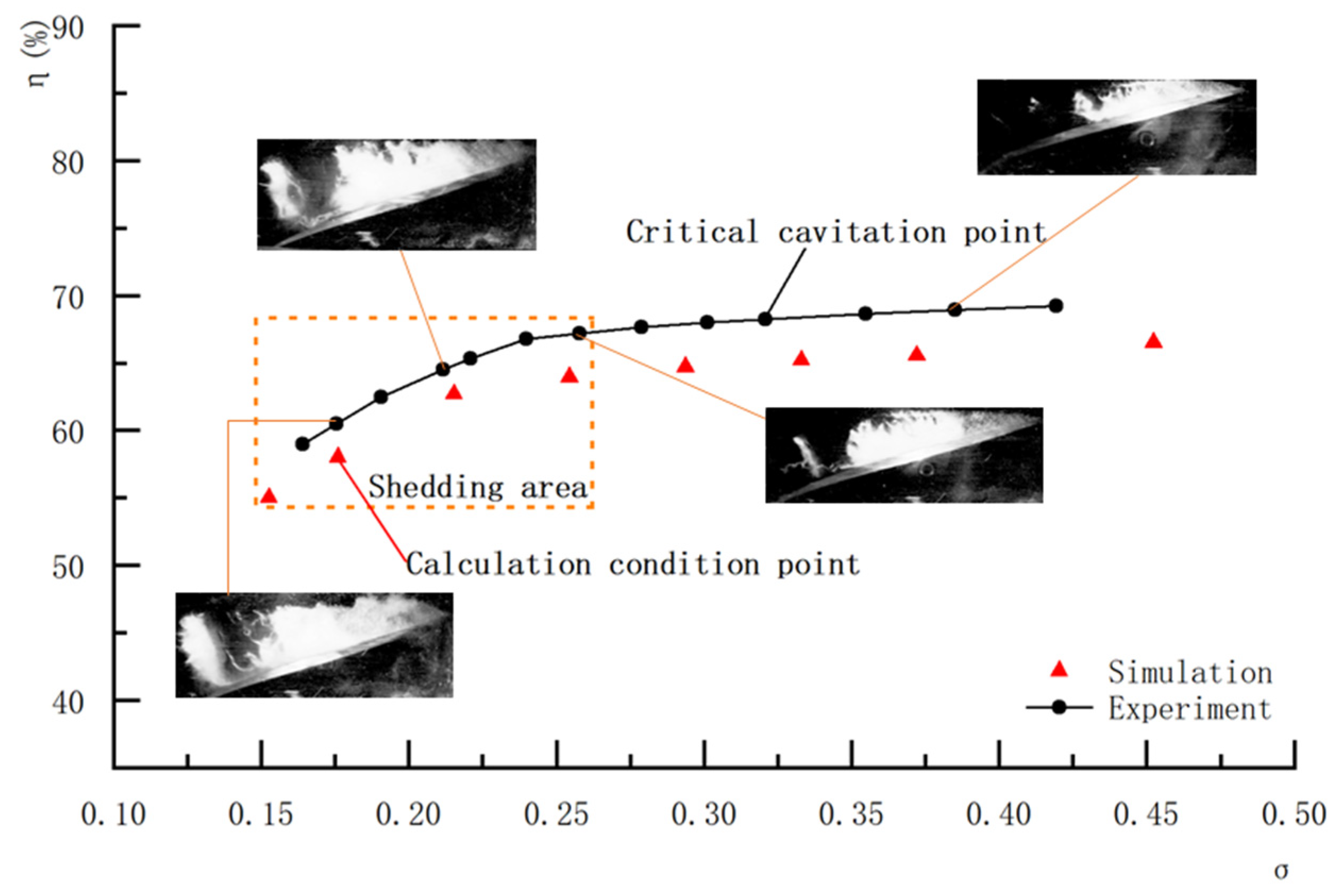
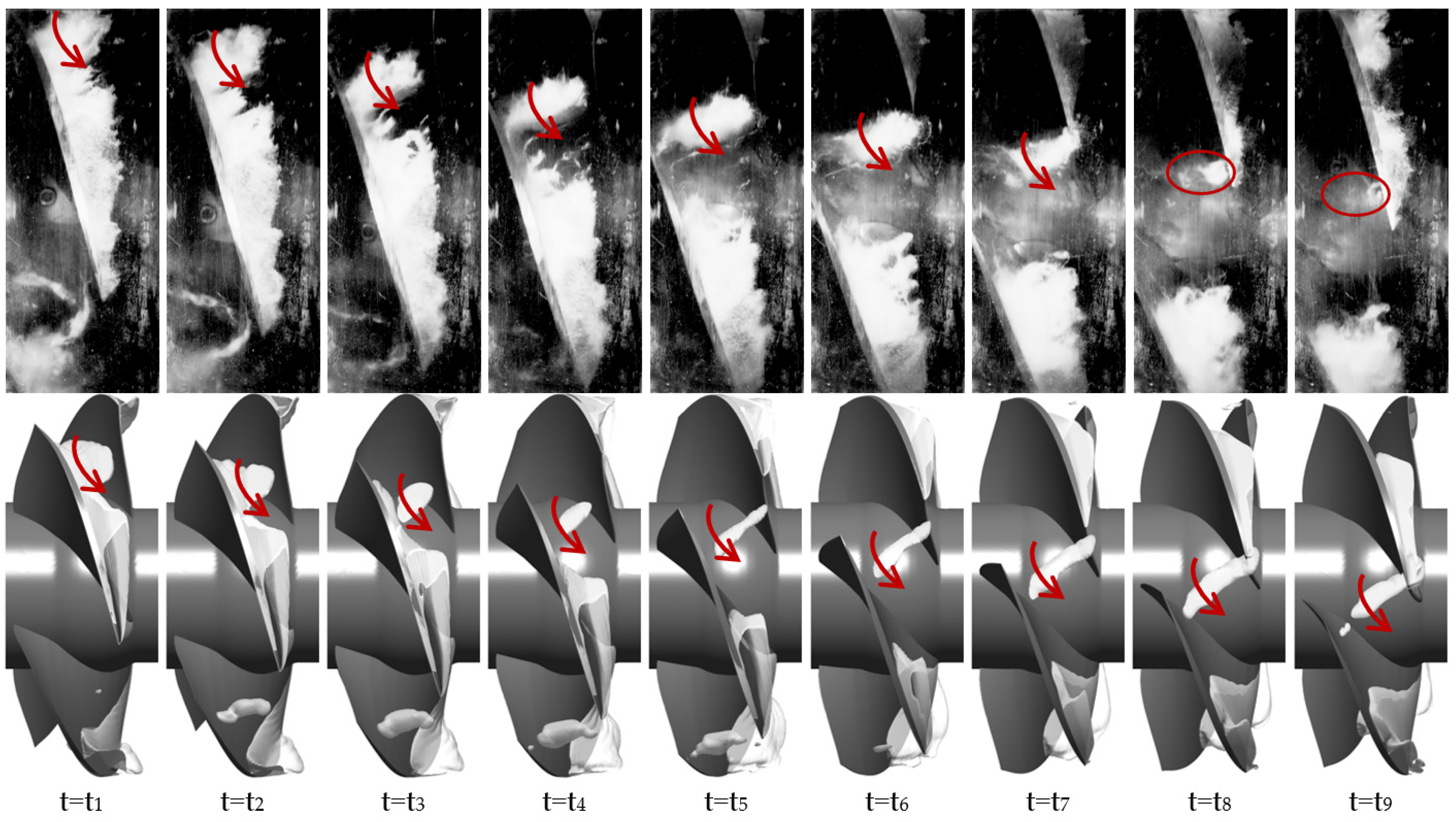



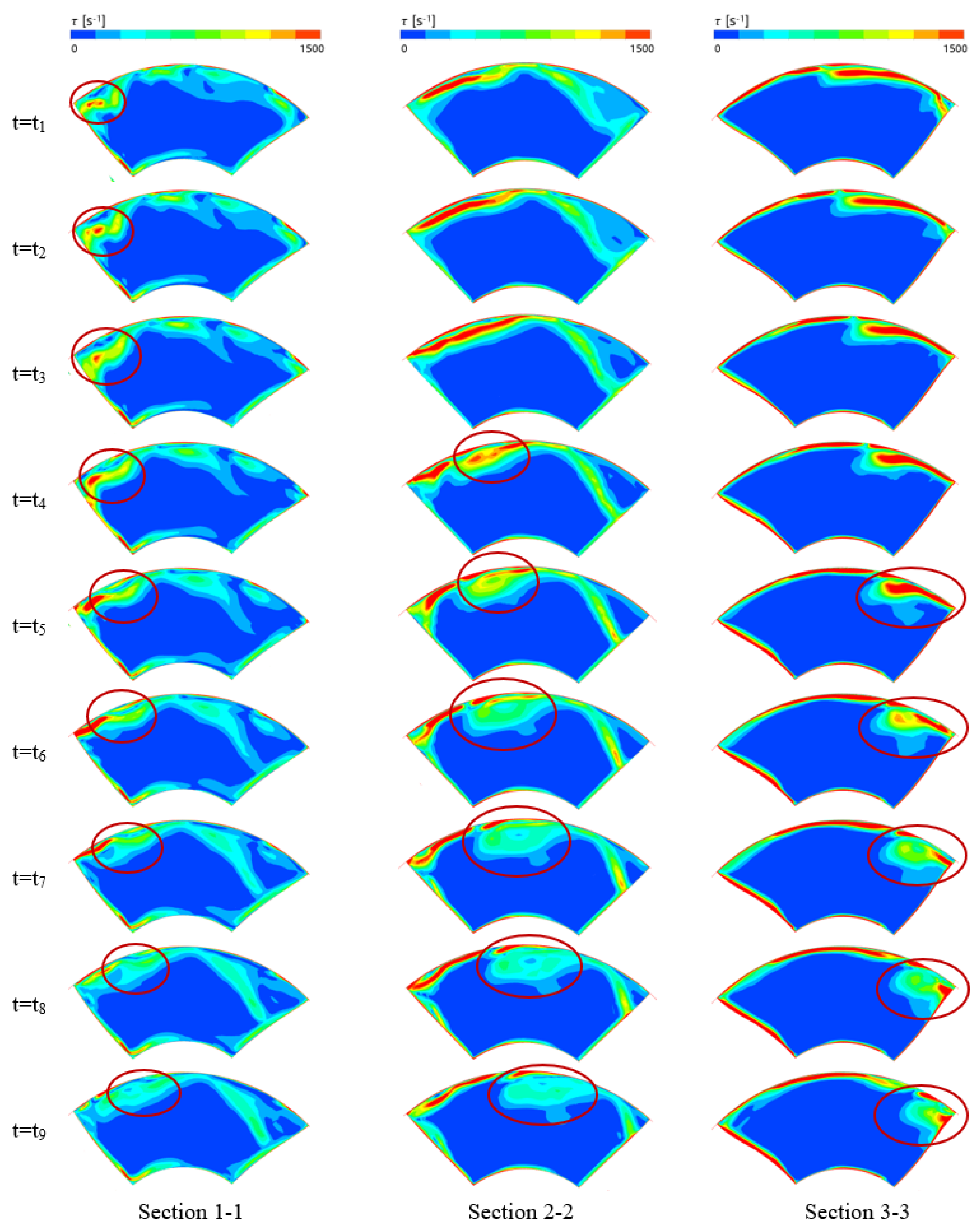
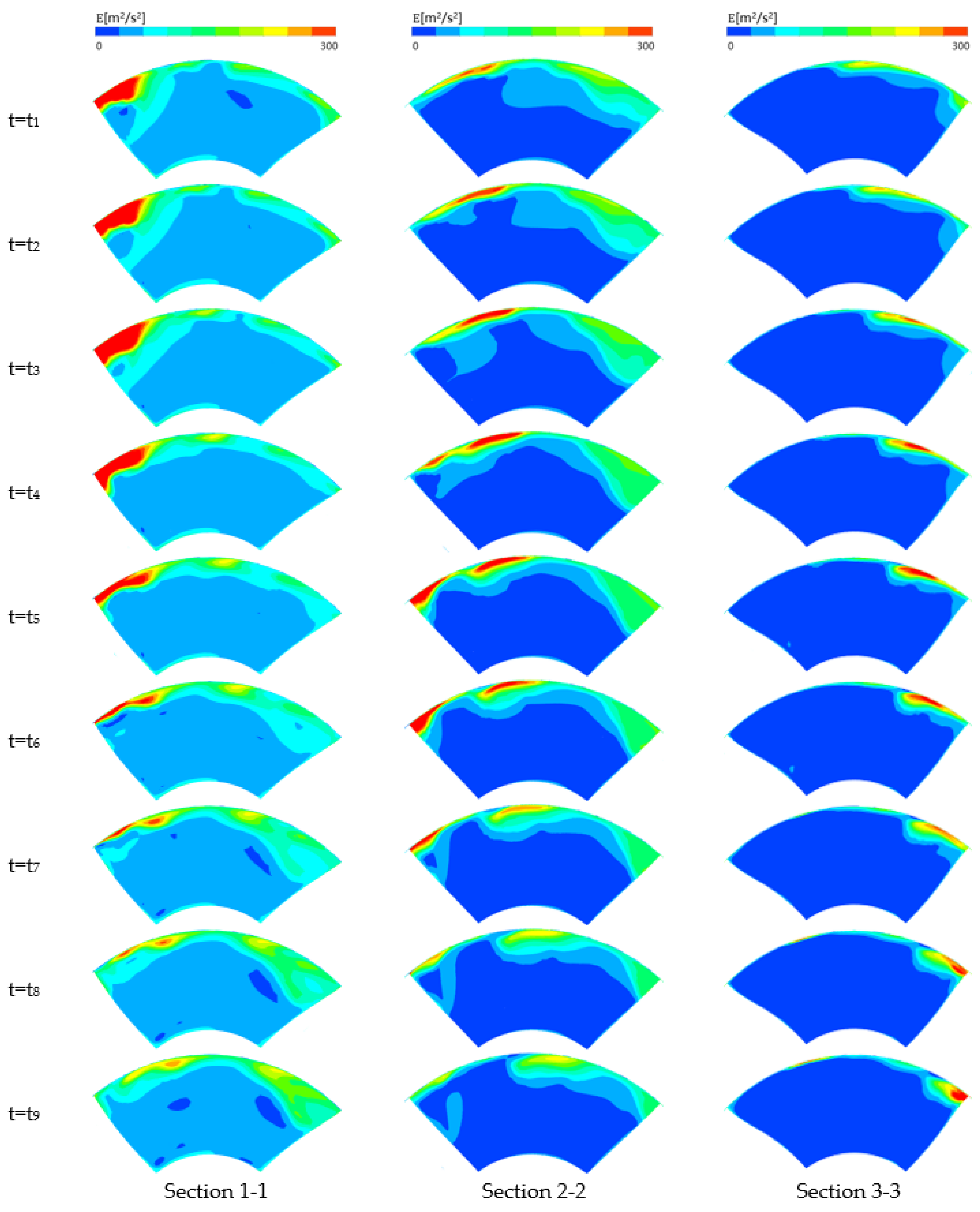
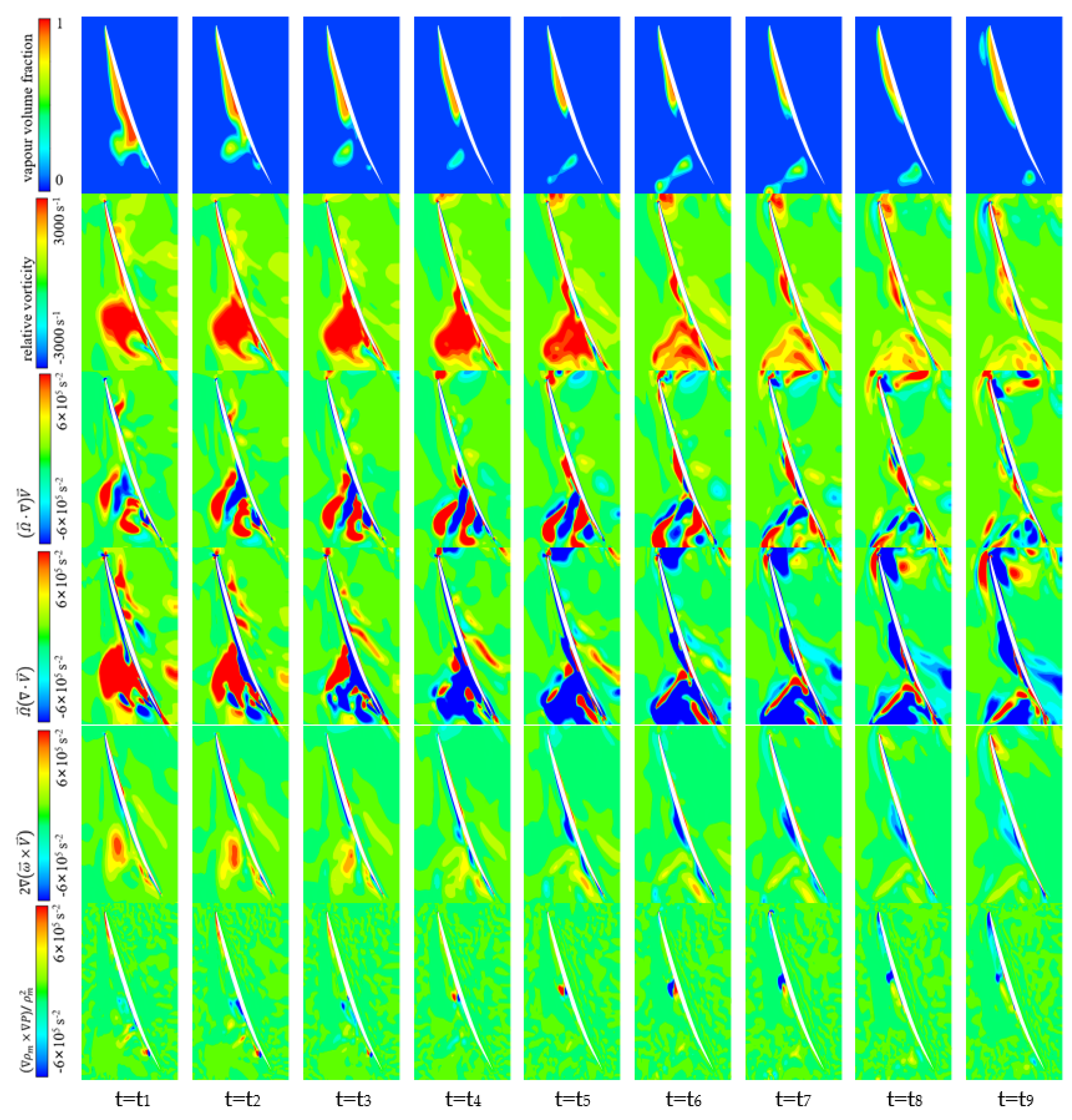
Publisher’s Note: MDPI stays neutral with regard to jurisdictional claims in published maps and institutional affiliations. |
© 2021 by the authors. Licensee MDPI, Basel, Switzerland. This article is an open access article distributed under the terms and conditions of the Creative Commons Attribution (CC BY) license (https://creativecommons.org/licenses/by/4.0/).
Share and Cite
Wang, L.; Tang, F.; Chen, Y.; Liu, H. Evolution Characteristics of Suction-Side-Perpendicular Cavitating Vortex in Axial Flow Pump under Low Flow Condition. J. Mar. Sci. Eng. 2021, 9, 1058. https://doi.org/10.3390/jmse9101058
Wang L, Tang F, Chen Y, Liu H. Evolution Characteristics of Suction-Side-Perpendicular Cavitating Vortex in Axial Flow Pump under Low Flow Condition. Journal of Marine Science and Engineering. 2021; 9(10):1058. https://doi.org/10.3390/jmse9101058
Chicago/Turabian StyleWang, Lin, Fangping Tang, Ye Chen, and Haiyu Liu. 2021. "Evolution Characteristics of Suction-Side-Perpendicular Cavitating Vortex in Axial Flow Pump under Low Flow Condition" Journal of Marine Science and Engineering 9, no. 10: 1058. https://doi.org/10.3390/jmse9101058
APA StyleWang, L., Tang, F., Chen, Y., & Liu, H. (2021). Evolution Characteristics of Suction-Side-Perpendicular Cavitating Vortex in Axial Flow Pump under Low Flow Condition. Journal of Marine Science and Engineering, 9(10), 1058. https://doi.org/10.3390/jmse9101058






